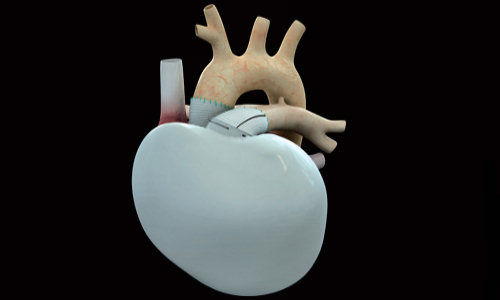An artificial heart containing miniaturised space technology will soon beat inside a person, having now been approved for human trials in France.
With heart disease killing over 100 million people in developed countries alone and the demand for transplants far exceeding donations, creating a totally artificial heart has been the holy grail of cardiovascular medicine for half a century.
Brainchild of the visionary cardiac surgeon, Professor Alain Carpentier, the prosthetic is the result of 15 years of collaboration with aerospace giant Astrium, the space subsidiary of EADS. In 2008, with support from the French Government and investors, Prof. Carpentier founded the EADS spin-off company, Carmat, to complete the work.
Combining the unique expertise of Prof. Carpentier, known worldwide for inventing today’s most used heart valves, with Astrium’s experience in building satellites, Carmat produced their first completely artificial heart earlier this year.
It turned out that space had the ingredients that Carmat needed. Working closely with satellite engineers, the company applied Astrium’s expertise in building spacecraft to guarantee the necessary precision and durability for an artificial human organ like a heart.
Fashioned in part from biological tissue and in part from miniature satellite equipment, the device combines the latest advances in medicine, biology, electronics and materials science to imitate a real heart.
The team had to build a device that could withstand the tough conditions of the body’s circulatory system and pump 35 million times per year for at least five years without fail. They needed the ultimate in reliability, and the answer came from design methodologies, testing strategies and know-how for the electronics on satellites.
“Space and the inside of your body have a lot in common,” says Matthieu Dollon, Head of Business Development in Astrium’s French Elancourt Equipment team, who are working closely with Carmat on the heart.
“They both present harsh and inaccessible environments.”
Telecom satellites are built to last 15 years on their own in space, 36 000 km above Earth. The heart might be closer than a satellite but it is just as inaccessible.
“Failure in space is not an option.Nor is onsite maintenance. If a part breaks down, we cannot simply go and fix it. It’s the same inside the body.”
Equally, space engineers tolerate no interruptions or bugs in their electronics. Team member Dung Vo-Quoc, who designed some of the vital electronics for the heart, points out: “If your satellite stops working during the final penalty of the football world cup it’s disappointing. But if a heart stops beating for five seconds, it’s fatal.
“We try hard to make sure that every single part will function as planned for the duration of the device.”
Story Source:
The above story is based on materials provided by The European Space Agency (ESA).





